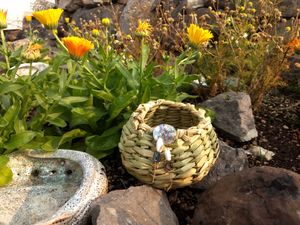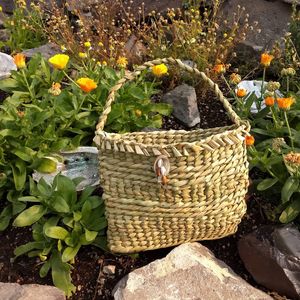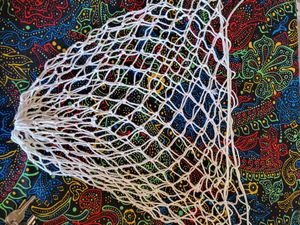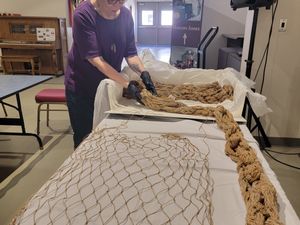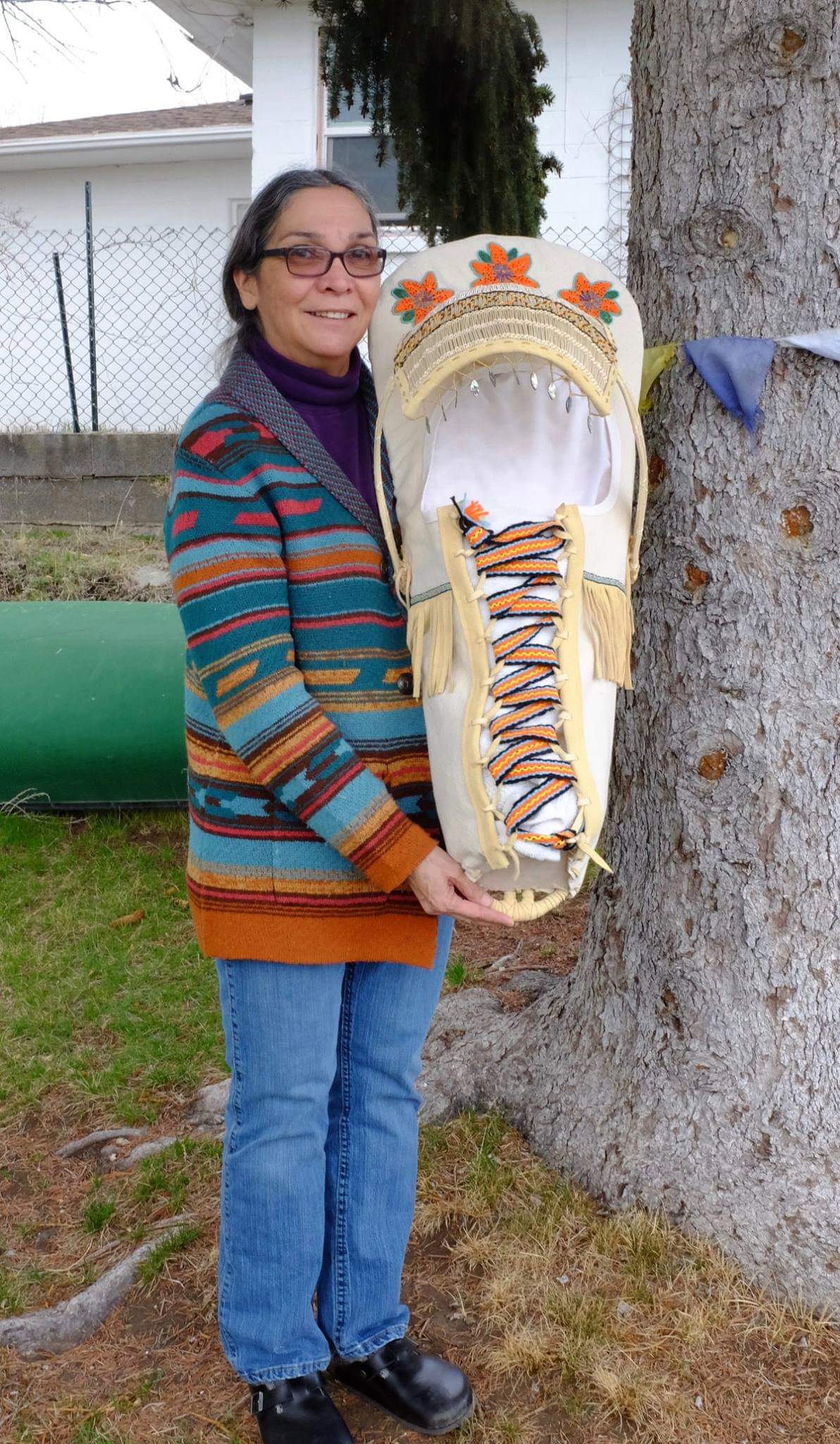
Sep 13, 2025
FolkLife Traditions at National Historic Oregon Trail Interpretive Center
Crossroads Carnegie Art Center, Friends Organization for the
National Historic Oregon Trail Intrepretive Center
in Partnership with Oregon Folklife Network
Funded by the James and Marion Miller Foundation
Presents
Folklife Traditions
at the National Historic Oregon Trail Intrepretive
October 16th, 17th, 18th 2025 in the Wagon Box Theatre
We welcome Sara Barton, Basket Weaver and Oregon Cultural Keeper
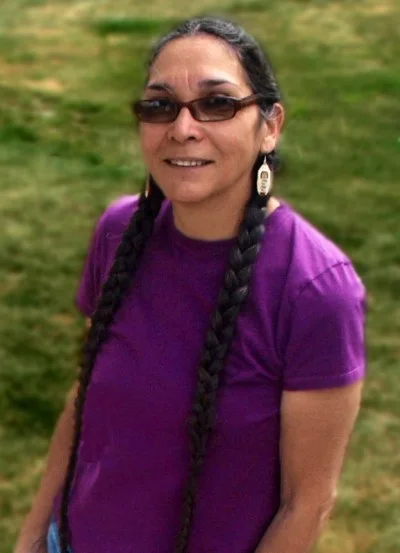
Each day Sara will be onsite demonstrating from 10am to 5pm.
Each day at 11 am, 1 pm, and 3pm she will do a short presentation sharing more detailed information about her history, tradtion, and craft.
Sara will present:
October 16th- Willow Baskets
October 17th- Tule Baskets
October 18th- Rabbit Nets
Sara's Story:
I am of the Yosemite Miwuk and Mono Lake Paiute First Nation People. My teachings started out when I was 29 years old, when I was working in the live history program at the Yosemite National Park museum and visitor center. I've been a serious basket weaver for over 20 years. I taught and demonstrated this traditional life way for over 30 years. I also work with other traditional mediums, such as various basketry materials, willows, tule reed, cattails and cornhusks. I also work with Dogbane, Milkweed, Stinging Nettle and cattails for my cordage making projects. I work with Elk and Deer antlers and bone for awls, hair sticks and jewelry.
For much of my time in Burns Oregon I was honored to be an apprentice to Minerva Sousie, a Master Basket Weaver for the Burns Paiute Tribe. Minerva taught how to make the various types of Paiute Baskets. Another Burns Paiute elder Rena Beers was gracious enough to teach me how to make a special Boat Style Newborn Cradle Basket using Willow.
In my work, I attempt to educate the contemporary viewers a small portion of what our elders experience as they worked on their creative art.
With these ancient art forms and traditional knowledge, and our close connection to our Mother Earth, I strive to bring a sense of well being and community.
I believe there is a holistic aspect to basket weaving and other artistic expressions. One of the benefits is that it requires a state of mindfulness, focus and concentration which are beneficial for reducing stress and anxiety.
Creating something unique and meaningful has proven to be an effective way to promote positive emotions, and boost self esteem.
It creates a sense of accomplishment and satisfaction, boosting confidence and self worth. It teaches patience and persistence. It encourages them to problem solve.
Working together, whether it be weaving baskets or other creative arts, it also creates a sense of belonging, especially for those who feel isolated or disconnected. It provides a way to connect with others through a shared interest.
One of my many goals is to teach others about our connection to Mother Earth and all she has to offer, How to work with nature and her resources in a respectful way.
The offical press release announcing the program and this first program.
RE: Partnership with the Oregon Folklife Network for Folk Residencies at the National Historic Oregon Trail Interpretive Center.
The National Historic Oregon Trail Interpretive Center (NHOTIC) will host a series of Oregon Folklife Residencies starting in October of 2025 and continuing in 2026.
Crossroads Carnegie Art Center, the Friends Organization for NHOTIC reached out to the Oregon Folklife Network to develop a plan to bring Oregon Cultural Keepers to Eastern Oregon to share their traditions funded by the James and Marion Miller Foundation.
The first folk residency will bring Sara Barton (Hines) who is a traditional Basketmaker who hails from a long line of Basketmakers. Though her own ancestry is a mix of Mono Lake Paiute and Yosemite Miwuk, she now assists the Burns Paiute in keeping their basket and cradleboard traditions.
Sara will be demonstrating in the Wagon Box Theatre inside the Interpretive Center for three full days from 10am to 5pm starting on Thursday October 16th at 10am.
Each day she will demonstrate all day and at 11am, 1pm and 3pm she will give a short presentation to guests including sharing in greater detail her lifelong training as a basket weaver. Guests of the center can ask questions and learn about her unique weaving style.
On October 16th she will be demonstrating her Willow Basket weaving traditions.
On October 17th she will demonstrate her Tule or cattail weaving traditions. Tule is a tall plant, often called tule reed or bulrush, that thrives in the shallow waters of marshes, lakes, and rivers and is used in various weaving techniques, such as twining, to create baskets for many purposes, including carrying food and drying items.
On October 18th Sara will be demonstrating a new technique creating “Rabbit Nets” that Sara is currently teaching to members of the Burns Paiute Tribe. Sara recently worked with the Curator of Churchill County Museum in Fallon Nevada who allowed Sara to look at a historic Rabbit Net in their collection.
Rabbit Nets were traditionally woven from Dogbane to assist the capturing of rabbits which were a significant part of the Paiute tribal traditions. Due to their fragile nature many of the historic nets did not survive. Sara’s work to engage new tribal members in the history and construction of Rabbit Nets, will ensure this Burns Paiute tradition is not lost.
Raised in the Mono Lake area of California, east of Yosemite National Park, Sara Barton comes from a long line of Basketmakers. Her tribal ancestry is a mix of Mono Lake Paiute and Yosemite Miwuk. When Sara moved to Burns, she came to know Minerva Soucie, a master Basketmaker on the Burns Paiute reservation whose work was known throughout Oregon. As their friendship grew, Minerva began to share stories of her people, especially when they were gathering willow and cattails (tules) together. Minerva’s hope was that her people would continue to make cradleboards. Perhaps she sensed Sara was the person to ensure that would happen. When Sara took Minerva’s cradleboard-making class, she was transformed. Cradleboards soon became a passion for her. Sara has now become a teacher to the Burns Paiute people, helping them renew their basket and cradleboard-making traditions. Sara also occupies her time with other types of handwork. Her regalia, worn for dancing and public speaking, was nine years in the making. Sara worked on different facets over time, including the dress itself, the belt, fan, etc. Her buckskin dress is embellished with Olivella, bull pine, and abalone shell accent pieces. Sara cut and polished the abalone herself. The necklace, beaded in a lace pattern by her cousin, took 100 hours to complete.
The goal of this residency program is to host this first event in the Fall of 2025 to develop the systems and structure to ensure excellent programming that will inspire visitors to the National Historic Oregon Trail Interpretive Center. Then starting in April of 2026 through October of 2026, the goal is to do a 3-day residency monthly with each month welcoming an Oregon Cultural Keeper to share their folk tradition, especially those traditions that would have been used during the western migration.
The National Historic Oregon Trail Interpretive Center is located at 22267 OR Hwy 86 in Baker City, Oregon and is open from 10 am to 5pm. Admission is charged and for prices please go to www.nhotic.com
For more information, please contact NHOTIC at 541-523-1843
“Oregon Folklife Network is a proud supporter of Oregon's culture keepers who sustain the diverse traditions that make our state vibrant. We are excited to see the National Historic Oregon Trail Interpretive Center embrace an Indigenous culture bearer, Sara Barton, as their first artist in residency. Doing so recognizes the legacy of Native communities in Oregon since time immemorial and uplifts the important contributions they continue making in our state today. Sara took up the urgent call to enliven Burns Paiute basketry, and visitors to the Interpretive Center will be fortunate to learn more about weaving from her.” Emily West Hartlerode, Director of the Oregon Folklife Network.
“Crossroads as the Friend’s Organization, encouraged by BLM staff, reached out to Oregon Folklife Network to investigate the possibility of developing a regular series of programs highlighting the amazing talents of the Oregon Cultural Keepers Roster, managed by OFN. They were immediately receptive to the idea, and with the support of the James and Marion Miller Foundation, who have funded Crossroads and our work with NHOTIC for three years. This program is designed to bring Oregon Cultural Keepers with folk traditions that would have been in practice during the westward migration and that have deep ties in Eastern Oregon. We are thrilled to welcome Sara Barton, to NHOTIC to share the rich history of the Burns Paiute Tribe and their basket weaving traditions.” Ginger Savage, Executive Director of Crossroads.
“The National Historic Oregon Trail Interpretive Center is exited and honored to have Sara Barton as our Friends Organization’s first folk resident. We hope that visitors and the community will join us to learn more about this timeless artform. NHOTIC is forever grateful to the Friends Organization for coordinating this opportunity and we look forward to the engagement.” Sarah Sherman, Acting Center Manager.
About the National Historic Oregon Trail Interpretive Center:
“The National Historic Oregon Trail Interpretive Center at Flagstaff Hill portrays and interprets the Oregon Trail experience and its related themes, while preserving and protecting its historic, cultural heritage, natural, and visual features. The Center serves as a focal point for the cultural heritage traveler, contributes a viable tourism industry for the area, and is committed to maintaining strong community partnerships.”
The National Historic Oregon Trail Interpretive Center (NHOTIC): A Bureau of Land Management Museum which opened in 1992 to tell the Oregon Trail Story from the Oregon perspective and was the first of four interpretive centers in Oregon.
About Crossroads:
Crossroads Carnegie Art Center became the Friends Organization for NHOTIC in 2023 to support the mission of NHOTIC and to assist in expanding Arts, Culture, Heritage and Humanities programming. The mission of the Crossroads Carnegie Art Center, Inc., a 501(c)3 non-profit founded in 1963, is to create opportunities for the entire community to be engaged, inspired, and transformed by the arts through participation in classes, workshops, exhibits, mentorships, and partnerships – A welcoming place where all ages meet and the arts speak.
About the Oregon Folklife Network:
The Oregon Folklife Network is the state of Oregon’s folk and traditional arts program. Administered by the Museum of Natural and Cultural History, OFN comprises a network of partners working to document, support, preserve, and celebrate the diversity of Oregon’s living cultural heritage. Oregon Folklife Network documents, supports, and celebrates Oregon's diverse cultural traditions and tradition-bearers. OFN conducts fieldwork research and works with communities, organizations, and Tribes to increase public awareness about Oregon’s living traditional arts and cultural heritage.
The Oregon Folklife Network serves as a hub for statewide folklife activities in partnership with the Oregon Arts Commission, Oregon Cultural Trust, Oregon Historical Society, Oregon State Library, and Oregon Heritage Commission, along with community partners including Tribes, community-based cultural organizations, museums, regional cultural alliances, local arts agencies, K-12 schools, universities and colleges, and public libraries.
What is Folklife: Folklife encompasses the everyday knowledge, art, and lore in communities whose members share a common language, ethnic heritage, religion, occupation, or geographic home. Our folklife changes as people change, as our environment changes, and as groups interact. Folklife includes forms as new as hip hop and as ancient as Native American basket weaving.
A culture keeper, also called a folk or traditional artist, is recognized by their community for actively practicing, passing on, and preserving their shared traditions.
